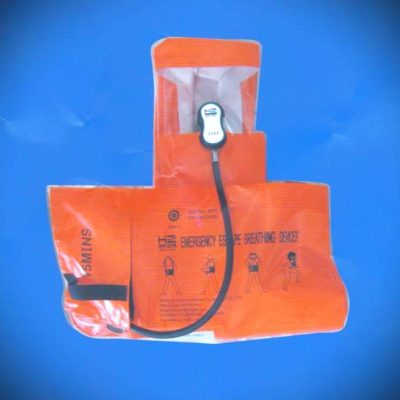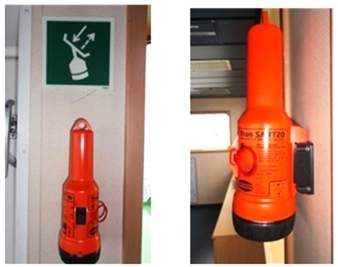An emergency escape breathing device (EEBD) is a type of personal protective equipment that allows a person to escape from a hazardous environment, such as a fire or a gas leak, on board a ship. EEBDs are designed to provide a minimum of 10 minutes of breathable air, enough time to reach a safe area or muster station.

Fire is one of the most serious hazards that may encounter if you work on ships. It can spread quickly, produce toxic smoke, and cut off your escape routes. That’s why you need to have specific fire protection equipment, escape device and training to deal with such emergencies.
One of the most important fire protection equipment you need onboard ships is EEBD, or Emergency Escape Breathing Device. EEBD is a device that provides you with breathable air for a short time, allowing you to escape from a compartment that has a hazardous atmosphere. EEBD can save your life if you are trapped by fire, smoke, or gas.
WHAT IS EEBD?
EEBD stands for Emergency Escape Breathing Device. It is a device that consists of a hood or mask, a compressed air cylinder, a pressure regulator, and a hose. The device provides you with breathable air for about 10 minutes, depending on the size of the cylinder and your breathing rate.
EEBD is designed to be used only for escape purposes, not for firefighting or rescue operations. EEBD is not intended to protect you from heat, flames, or falling objects. EEBD is also not suitable for entering confined spaces or areas with low oxygen levels.
EEBD is different from SCBA (Self-Contained Breathing Apparatus), which is a device that allows you to breathe in any environment for a longer time. SCBA is used by firefighters and rescue teams who need to enter hazardous areas and perform tasks. SCBA requires more training and maintenance than EEBD.
HOW DOES EEBD WORK?
EEBD works by supplying you with compressed air from a cylinder through a pressure regulator and a hose. The air flows into a hood or mask that covers your head and face. The hood or mask has a clear visor that allows you to see where you are going. The hood or mask also has an exhalation valve that releases your exhaled air to the outside.
To use EEBD, you need to follow these steps:
- Locate an EEBD in an easily visible and accessible place near your escape route.
- Grab the EEBD and pull the strap to release it from its container.
- Open the valve on the cylinder to start the air flow.
- Put on the hood or mask over your head and adjust it to fit snugly.
- Breathe normally and calmly through your nose or mouth.
- Follow the escape route signs and instructions to reach a safe place.
- Discard the used EEBD in a designated area.
REQUIREMENTS AND RECOMMENDATIONS
EEBD is mandatory under the new amendments to SOLAS 74 (Chapter II-2, Reg 16) for all ships to which the safety equipment certificate is required. The specific technical standards for EEBD can be found in the International Code for Fire Safety Systems (FSS Code).
According to the regulations, the minimum number and placement of EEBDs onboard ships are as follows:
- All cargo ships must carry at least 2 EEBDs in the accommodation area.
- All passenger ships must carry at least 2 EEBDs in each main vertical zone.
- Passenger ships carrying more than 36 passengers must carry 2 additional EEBDs in each main vertical zone.
- In machinery spaces, at least one EEBD must be provided at the engine control room, the machine shop or workshop area, and near each escape ladder.
- Additional spare EEBDs must be carried depending on the total number of EEBDs onboard: one spare for 10 or less EEBDs, two spares for 11 to 20 EEBDs, and 10% of the total (but no more than 4) spares for more than 20 EEBDs.
The number and location of EEBDs and spares must be indicated in the fire control plan. The EEBDs must be stored in protective containers that are clearly marked and easily opened. The EEBDs must be inspected and maintained regularly according to the manufacturer’s instructions.
HOW TO USE EEBD SAFELY AND EFFECTIVELY?
EEBDs are designed to be easy to use and carry, but they require some basic knowledge and skills to operate them safely and effectively. Here are some tips on how to use EEBD properly:
- Before entering a confined space, check the EEBD for any signs of damage, leakage, or expiration date. Make sure the EEBD is fully charged and ready to use.
- Wear the EEBD on your chest or waist, and keep it accessible at all times. Do not store it in a locker or a cabinet that may be difficult to reach in an emergency.
- If you encounter an emergency situation where the air is unsafe to breathe, activate the EEBD by pulling the red tab or breaking the seal. This will start the flow of oxygen from the cylinder to the hood or mask.
- Put on the hood or mask over your head and face, and adjust it to fit snugly. Make sure there are no gaps or leaks around the edges. Breathe normally and calmly through your mouth or nose.
- Follow the escape route to the nearest exit or safe area. Do not stop or go back unless absolutely necessary. Avoid any sources of fire, sparks, or heat that may ignite the oxygen.
- Once you reach a safe area, remove the hood or mask and discard the EEBD. Seek medical attention if you have any symptoms of smoke inhalation, such as coughing, wheezing, chest pain, or difficulty breathing.
EEBDs are lifesaving devices that can help you escape from a hazardous environment. However, they are not a substitute for proper safety measures and precautions. Always follow the rules and regulations of your workplace and be aware of the potential risks and hazards. Stay safe!




